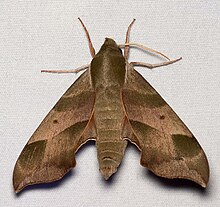|
Darapsa myron
Darapsa myron, the Virginia creeper sphinx, is a moth of the family Sphingidae found in central and eastern North America. DistributionIt is found in southern Ontario and Quebec in Canada,[2] and in the United States is found from Maine south to south Florida; west to North Dakota, Nebraska, New Mexico, Oklahoma, and Texas. It also can be found in Mexico. Description
BiologyThere are two or three broods in much of the range, and larvae can mature in as few as three weeks. Larvae hide on the midribs of their host leaves and are nocturnal feeders. During July and August, this species is abundant in many areas, particularly Massachusetts and Pennsylvania. Adults emerge in the mid-afternoon and females begin calling bob after dusk. In spring, adults are more likely to feed, nectaring from flowers and drinking fluids from rotting fruit. In areas where they are common, D. myron readily come to both lights and sugar baits, being most active between sunset and midnight. Females have much rounder abdomens while the end of the male's abdomen is spade-shaped. Pairing is fairly quick and captive adults do not need to be fed, although females lay more eggs when fed. Sometimes adults refuse food altogether. Mated females deposit up to 150 small eggs that start out green but turn yellow within 48 hours, indicating fertility. Incubation lasts about six days. Full grown caterpillars pose the ability to chew though sleeves. Fully grown larvae turn a purplish brown before spinning a sparse, wiry cocoon among host leaves. Pupae either enclose within about 20 days or diapause, eclosing in late May.[citation needed] The larvae are known to feed on Virginia creeper, Viburnums, grape vines, and raccoon grapes.[3] Subspecies
References
External links
|
||||||||||||||||||||||||||||||||||




